2001 BMW 325i SEDAN key battery
[x] Cancel search: key batteryPage 20 of 211
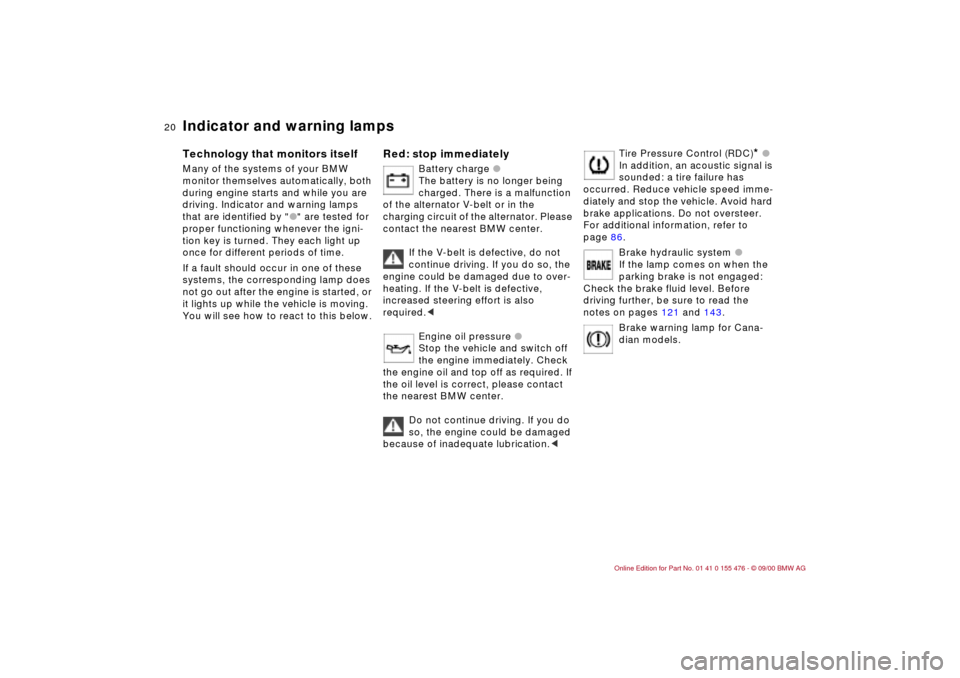
20n
Indicator and warning lamps Technology that monitors itself Many of the systems of your BMW
monitor themselves automatically, both
during engine starts and while you are
driving. Indicator and warning lamps
that are identified by "l" are tested for
proper functioning whenever the igni-
tion key is turned. They each light up
once for different periods of time.
If a fault should occur in one of these
systems, the corresponding lamp does
not go out after the engine is started, or
it lights up while the vehicle is moving.
You will see how to react to this below.
Red: stop immediately
Battery charge l
The battery is no longer being
charged. There is a malfunction
of the alternator V-belt or in the
charging circuit of the alternator. Please
contact the nearest BMW center.
If the V-belt is defective, do not
continue driving. If you do so, the
engine could be damaged due to over-
heating. If the V-belt is defective,
increased steering effort is also
required.<
Engine oil pressure
l
Stop the vehicle and switch off
the engine immediately. Check
the engine oil and top off as required. If
the oil level is correct, please contact
the nearest BMW center.
Do not continue driving. If you do
so, the engine could be damaged
because of inadequate lubrication.<
Tire Pressure Control (RDC)
* l
In addition, an acoustic signal is
sounded: a tire failure has
occurred. Reduce vehicle speed imme-
diately and stop the vehicle. Avoid hard
brake applications. Do not oversteer.
For additional information, refer to
page 86.
Brake hydraulic system l
If the lamp comes on when the
parking brake is not engaged:
Check the brake fluid level. Before
driving further, be sure to read the
notes on pages 121 and 143.
Brake warning lamp for Cana-
dian models.
Page 32 of 211
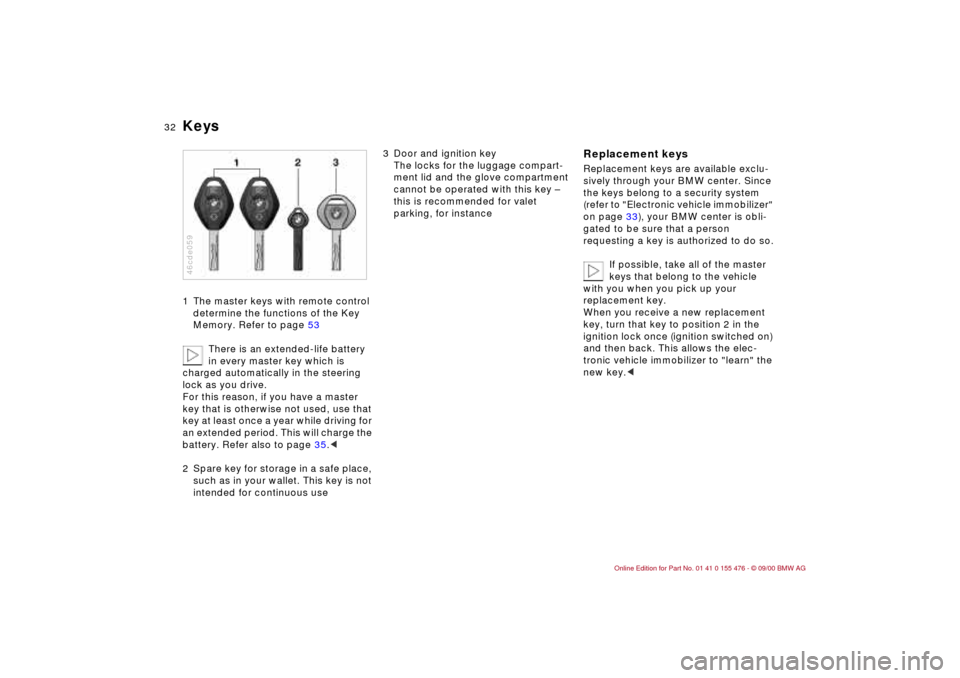
32n
Keys1 The master keys with remote control
determine the functions of the Key
Memory. Refer to page 53
There is an extended-life battery
in every master key which is
charged automatically in the steering
lock as you drive.
For this reason, if you have a master
key that is otherwise not used, use that
key at least once a year while driving for
an extended period. This will charge the
battery. Refer also to page 35.<
2 Spare key for storage in a safe place,
such as in your wallet. This key is not
intended for continuous use46cde059
3 Door and ignition key
The locks for the luggage compart-
ment lid and the glove compartment
cannot be operated with this key Ð
this is recommended for valet
parking, for instance
Replacement keysReplacement keys are available exclu-
sively through your BMW center. Since
the keys belong to a security system
(refer to "Electronic vehicle immobilizer"
on page 33), your BMW center is obli-
gated to be sure that a person
requesting a key is authorized to do so.
If possible, take all of the master
keys that belong to the vehicle
with you when you pick up your
replacement key.
When you receive a new replacement
key, turn that key to position 2 in the
ignition lock once (ignition switched on)
and then back. This allows the elec-
tronic vehicle immobilizer to "learn" the
new key.<
Page 35 of 211
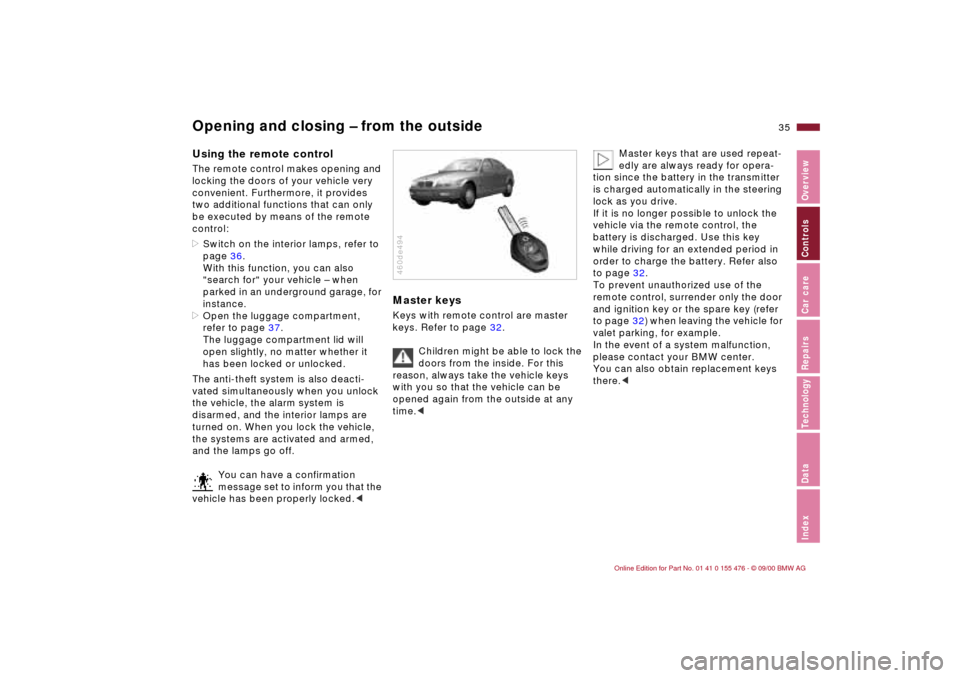
35n
IndexDataTechnologyRepairsCar careControlsOverview
Opening and closing Ð from the outsideUsing the remote control The remote control makes opening and
locking the doors of your vehicle very
convenient. Furthermore, it provides
two additional functions that can only
be executed by means of the remote
control:
>Switch on the interior lamps, refer to
page 36.
With this function, you can also
"search for" your vehicle Ð when
parked in an underground garage, for
instance.
>Open the luggage compartment,
refer to page 37.
The luggage compartment lid will
open slightly, no matter whether it
has been locked or unlocked.
The anti-theft system is also deacti-
vated simultaneously when you unlock
the vehicle, the alarm system is
disarmed, and the interior lamps are
turned on. When you lock the vehicle,
the systems are activated and armed,
and the lamps go off.
You can have a confirmation
message set to inform you that the
vehicle has been properly locked.<
Master keysKeys with remote control are master
keys. Refer to page 32.
Children might be able to lock the
doors from the inside. For this
reason, always take the vehicle keys
with you so that the vehicle can be
opened again from the outside at any
time.<460de494
Master keys that are used repeat-
edly are always ready for opera-
tion since the battery in the transmitter
is charged automatically in the steering
lock as you drive.
If it is no longer possible to unlock the
vehicle via the remote control, the
battery is discharged. Use this key
while driving for an extended period in
order to charge the battery. Refer also
to page 32.
To prevent unauthorized use of the
remote control, surrender only the door
and ignition key or the spare key (refer
to page 32) when leaving the vehicle for
valet parking, for example.
In the event of a system malfunction,
please contact your BMW center.
You can also obtain replacement keys
there.<
Page 42 of 211

42n
Alarm system
*
The conceptThe vehicle's alarm system responds:
>When a door, the hood or the
luggage compartment lid is opened.
>To movement inside the vehicle
(interior motion sensor).
>To a change of the vehicle's tilt Ð if
someone attempts to steal the wheels
or tow the vehicle without authoriza-
tion, for example.
>If there is an interruption of battery
voltage.
The system responds to unauthorized
vehicle entry and attempted theft by
simultaneously activating the following:
>Sounding an acoustical alarm for
30 seconds.
>The hazard warning flashers are acti-
vated for approx. five minutes.
>The high beams flash on and off in
the same rhythm.
To activate and deactivate the
alarm systemWhen the vehicle is locked or unlocked
by using a key or with the remote
control, the alarm system is also simul-
taneously armed or disarmed.
The interior motion sensor and the tilt
alarm sensor are activated approx.
30 seconds after you have finished
locking the vehicle.
If the alarm system has been armed
correctly, the hazard warning flashers
flash once.
You can have a signal set as
acknowledgment for both acti-
vating and deactivating the alarm.<
You can also open the luggage
compartment lid when the system is
armed by pressing button 3 of the
remote control (refer to page 37). When
it is closed, the lid is once again
secured.
Indicator lamp displaysThe indicator lamp is located under the
interior rearview mirror.
>When the indicator lamp flashes
continuously: the system is armed.
>If the indicator lamp flashes during
arming of the system: the door(s), the
hood or luggage compartment lid are
not completely closed. Even if you do
not close the alerted area, the system
begins to monitor the remaining
areas, and the indicator lamp flashes
continuously after 10 seconds.
However, the interior motion sensor
is not activated.
>If the indicator lamp goes out when
the system is disarmed: no manipula-
tion or attempted intrusions have
been detected in the period since the
system was armed.463us010
Page 63 of 211
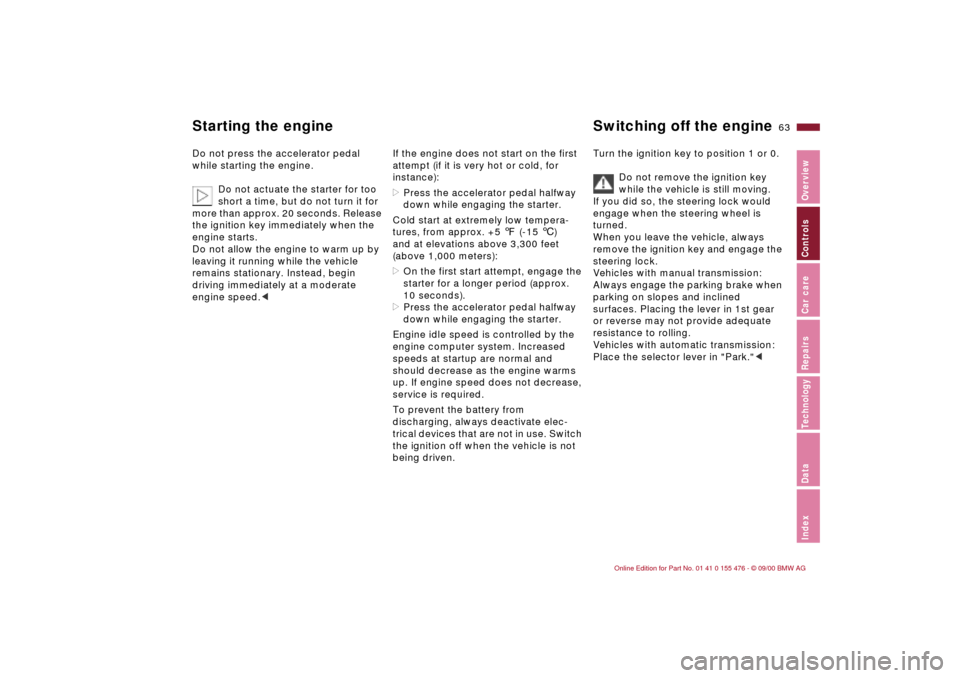
63n
IndexDataTechnologyRepairsCar careControlsOverview
Starting the engine Switching off the engine Do not press the accelerator pedal
while starting the engine.
Do not actuate the starter for too
short a time, but do not turn it for
more than approx. 20 seconds. Release
the ignition key immediately when the
engine starts.
Do not allow the engine to warm up by
leaving it running while the vehicle
remains stationary. Instead, begin
driving immediately at a moderate
engine speed.<
If the engine does not start on the first
attempt (if it is very hot or cold, for
instance):
>Press the accelerator pedal halfway
down while engaging the starter.
Cold start at extremely low tempera-
tures, from approx. +5 7 (-15 6)
and at elevations above 3,300 feet
(above 1,000 meters):
>On the first start attempt, engage the
starter for a longer period (approx.
10 seconds).
>Press the accelerator pedal halfway
down while engaging the starter.
Engine idle speed is controlled by the
engine computer system. Increased
speeds at startup are normal and
should decrease as the engine warms
up. If engine speed does not decrease,
service is required.
To prevent the battery from
discharging, always deactivate elec-
trical devices that are not in use. Switch
the ignition off when the vehicle is not
being driven.Turn the ignition key to position 1 or 0.
Do not remove the ignition key
while the vehicle is still moving.
If you did so, the steering lock would
engage when the steering wheel is
turned.
When you leave the vehicle, always
remove the ignition key and engage the
steering lock.
Vehicles with manual transmission:
Always engage the parking brake when
parking on slopes and inclined
surfaces. Placing the lever in 1st gear
or reverse may not provide adequate
resistance to rolling.
Vehicles with automatic transmission:
Place the selector lever in "Park."<
Page 90 of 211
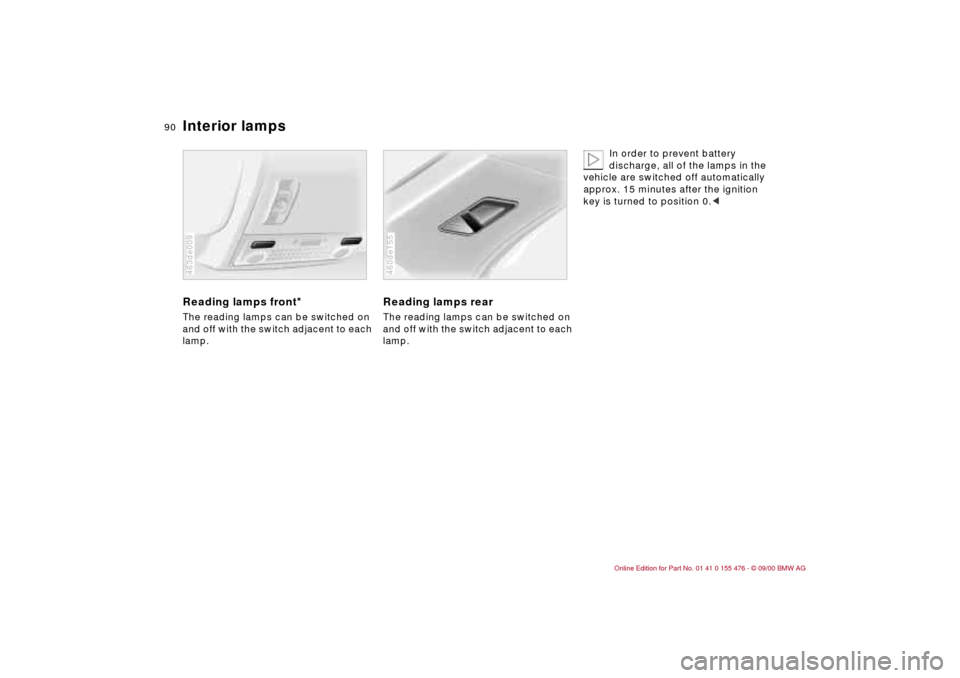
90n
Interior lamps
Reading lamps front
*
The reading lamps can be switched on
and off with the switch adjacent to each
lamp.463de009
Reading lamps rearThe reading lamps can be switched on
and off with the switch adjacent to each
lamp.460de155
In order to prevent battery
discharge, all of the lamps in the
vehicle are switched off automatically
approx. 15 minutes after the ignition
key is turned to position 0.<
Page 169 of 211
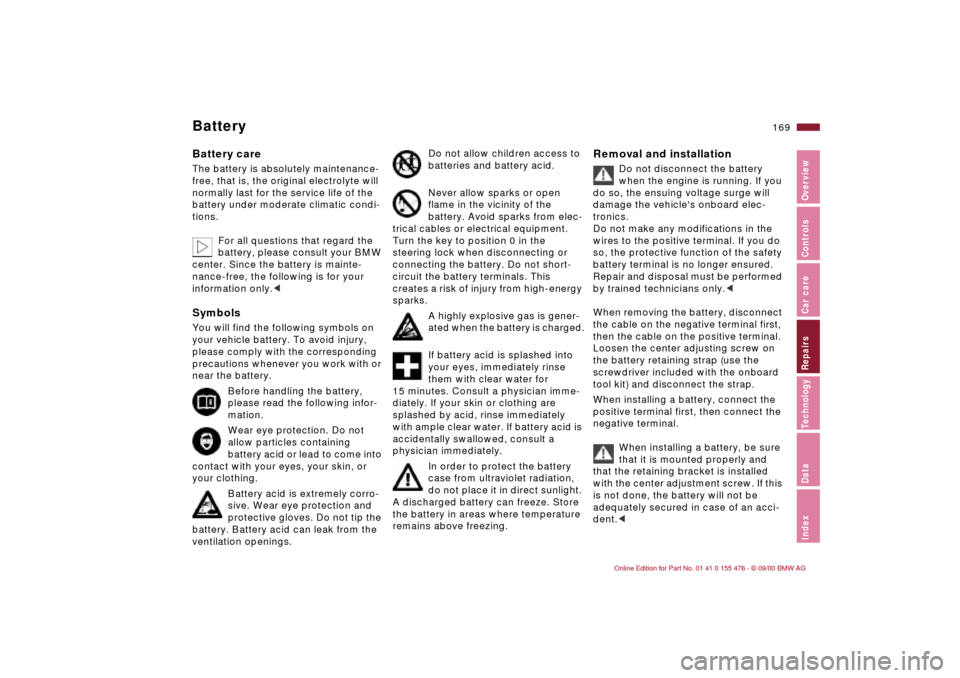
169n
IndexDataTechnologyRepairsCar careControlsOverview
BatteryBattery careThe battery is absolutely maintenance-
free, that is, the original electrolyte will
normally last for the service life of the
battery under moderate climatic condi-
tions.
For all questions that regard the
battery, please consult your BMW
center. Since the battery is mainte-
nance-free, the following is for your
information only.
please comply with the corresponding
precautions whenever you work with or
near the battery.
Before handling the battery,
please read the following infor-
mation.
Wear eye protection. Do not
allow particles containing
battery acid or lead to come into
contact with your eyes, your skin, or
your clothing.
Battery acid is extremely corro-
sive. Wear eye protection and
protective gloves. Do not tip the
battery. Battery acid can leak from the
ventilation openings.
Do not allow children access to
batteries and battery acid.
Never allow sparks or open
flame in the vicinity of the
battery. Avoid sparks from elec-
trical cables or electrical equipment.
Turn the key to position 0 in the
steering lock when disconnecting or
connecting the battery. Do not short-
circuit the battery terminals. This
creates a risk of injury from high-energy
sparks.
A highly explosive gas is gener-
ated when the battery is charged.
If battery acid is splashed into
your eyes, immediately rinse
them with clear water for
15 minutes. Consult a physician imme-
diately. If your skin or clothing are
splashed by acid, rinse immediately
with ample clear water. If battery acid is
accidentally swallowed, consult a
physician immediately.
In order to protect the battery
case from ultraviolet radiation,
do not place it in direct sunlight.
A discharged battery can freeze. Store
the battery in areas where temperature
remains above freezing.
Removal and installation
Do not disconnect the battery
when the engine is running. If you
do so, the ensuing voltage surge will
damage the vehicle's onboard elec-
tronics.
Do not make any modifications in the
wires to the positive terminal. If you do
so, the protective function of the safety
battery terminal is no longer ensured.
Repair and disposal must be performed
by trained technicians only.<
When removing the battery, disconnect
the cable on the negative terminal first,
then the cable on the positive terminal.
Loosen the center adjusting screw on
the battery retaining strap (use the
screwdriver included with the onboard
tool kit) and disconnect the strap.
When installing a battery, connect the
positive terminal first, then connect the
negative terminal.
When installing a battery, be sure
that it is mounted properly and
that the retaining bracket is installed
with the center adjustment screw. If this
is not done, the battery will not be
adequately secured in case of an acci-
dent.<
Page 204 of 211

Everything from A to ZRemoving condensation
from the
windows96,101
Replacement key32
Reporting safety defects7
Restraint systems55,59
Reverse17,65
Roller blind, sun
protection103
Roof load capacity194
Roof-mounted luggage
rack113
Rubber parts122 S
Safety belt tensioner183
Safety belts54
height adjustment54
Safety defects, reporting7
Safety feature44
Safety lock buttons38
Safety terminal, battery169
Seat
mechanical47
power49
Seat adjustment47
Seat heating103
Seat memory50
Securing cargo112
Securing loads112 Selector lever, automatic
transmission66
Self-defrosting mirrors52
Self-diagnostics187
Service and Warranty
Information Booklet145
Service Interval
Display75,145
Shiftlock66
Side airbags55
Side impact Head Protection
System55
Side lamps88
bulb replacement160
Ski bag110
Skid control123
Sliding/tilt sunroof45
closing following an
electrical malfunction172
convenience operation34
Slippery roads122
Snow chains122,129,1
31
Socket108
for flashlights108
for power supplies108
for vacuum cleaner108
Space-saver spare tire165
Spare key32
Spare tire165
Spare wheel165
Spark plugs196 Speaker107
Speed control72
Speed display18
Speedometer18
Sports seat49
Sports steering wheel with
multfunction buttons25
Starting62
Starting assistance173
Starting
problems117,173
Starting the engine62
Steel wheels130
Steering123
Steering wheel lock62
Steering wheel,
adjusting51
Steptronic66
Stopping the vehicle63
Storage compartments105
Storing the vehicle152
Stroke192
Summer tires128
Sun blind103
Sun visors52
Switching off the engine63
Symbols4,169
Synthetic oils140
T
Tachometer74 Tail lamp assembly, bulb
replacement161
Tail lamps161
Tank capacity195
Technical data192
Technical
modifications6,153
Telephone hookup107
Telephone, refer to the
separate Owner's Manual
Temperature
adjustment100
Temperature display
outside temperature77
Temperature gauge
engine coolant75
Temperature
layering95,102
Thigh support area,
adjusting49
Third brake lamp163
Three-point-safety belt in the
rear109
Through-loading
system109
Tilt alarm36,43
remote control36
Tire changing165
Tire codes128
Tire condition125
Tire damage125